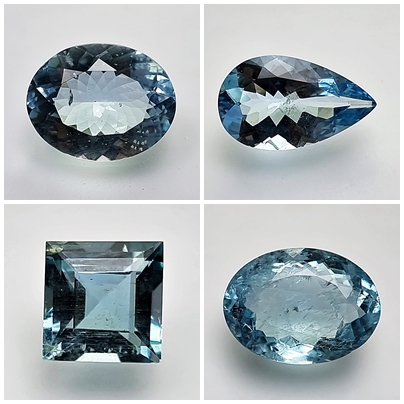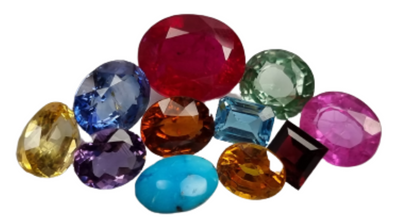
Brazilian Aquamarine: Gemstone Information
Crystals of beryl other than emerald occur most commonly in pegmatites whose cavities give the crystal the opportunity to grow to large size and allow clear areas to develop. This is why fashioned beryl can be among the larger gemstones. The finest Brazilian aquamarine is found in Brazil, where the pegmatite deposits of Minas Gerais produce the finest blues, blue-greens and yellow-green as well as pale green and golden beryl.
Beryl are also described in Principais depositos minerals do Brazil, vol. V, Parte A, published in 1991 by the Companhia de Pesquisa de Recursos Minerais of the Dept Nacional da Producão Mineral.
This is by far the most complete survey of Brazilian gem minerals, details and maps of the major mines accompanying statistics of production and virtually anything else the student might need. The text is in Portuguese – I have been unable to find an ISBN in my copy (MO’D). We have noted that the state of Minas Gerais produces the finest non emerald beryl: Oakenfull cites several large crystals. One more recently discovered crystal was named Marta Rocha after a Miss Brazil of the middle 1950s, the name persisting as a description of an especially fine dark blue. Large golden beryl crystals also occur in the state as well as pink beryl (morganite) whose color does not quite reach the excellence of those from Madagascar.
Fortaleza aquamarines come from the north of the state. The Maxixe blue beryl, a perpetual fascination for gemmologists, comes from mines in the Piauí valley of Minas Gerais; the deep blue color is subject to fading, though not quite so dramatically as popular legend suggests. The finer blue is shown by the ordinary ray – in other blue beryls the colour is in the extraordinary ray. The hexagonal crystals of aquamarine are often of large size and, owing to oscillation between the first- and second-order prisms, may be striated parallel to the prism edge. At times this striation may be sufficiently pronounced to obscure the hexagonal outline, the crystal assuming a ribbed cylindrical form.
Further, due to erosion, some aquamarine crystals may be tapered. However, Hintze, in Handbuch der Mineralogie, Bd 2, Silicate und Titanate (1897), does not emphasize this observation. Pale aquamarine may be heated to improve the colour but disclosure is not necessary nor is any test needed at least in the ornamental context. SG will lie between 2.66 and 2.80, specimens from some localities showing the higher values. RI will be in the range 1.572–1.590 for the extraordinary and ordinary ray respectively, uniaxial negative with DR 0.007–0.008. Dispersion at 0.014 is insignificant. Dichroic colours are a darker and a paler blue with the better colour seen in the extraordinary ray (compare Maxixe beryl). Two absorption bands, not notably strong or sharp, are at 456 and 427 nm. In Maxixe beryl there are strong bands in the red at 697 and 657 nm, with a weaker band in the orange at 628 nm.
Greenish blue Brazilian aquamarine which has escaped heating may show an absorption band in the green at 537 nm. This aquamarine is a subtle colour and may well be preferred to the perhaps more metallic blue of some heated stones. Like other beryls aquamarine is brittle. Apart from Brazil aquamarine is found in Namibia and crystals of weak colour in Zimbabwe. The Mourne Mountains in Northern Ireland have produced attractive aquamarine – a fine crystal is in the Natural History Museum in London. The only natural stone closely resembling aquamarine is blue topaz, which gives refractometer indices ranging from 1.610 and 1.620 appreciably higher than the values for aquamarine.




